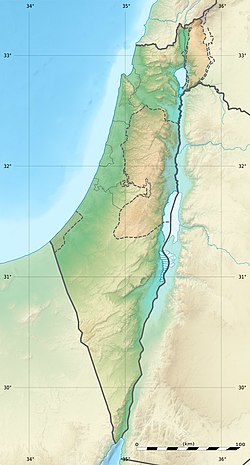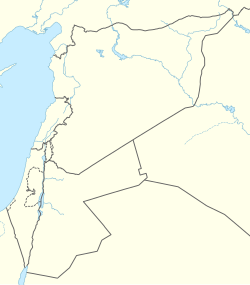اسدود | |
 Philistine pottery at the Museum of Philistine culture, Ashdod, Israel | |
| Location | Ashdod, Israel |
|---|---|
| Region | Levant |
| Coordinates | 31°45′13″N 34°39′42″E / 31.75361°N 34.66167°E |
| Type | Ancient Levantine city |
Ashdod (Philistine: 𐤀𐤔𐤃𐤃 *ʾašdūd; Hebrew: אַשְׁדּוֹד, romanized: ʾašdōḏ; Arabic: أسدود, romanized: ʾasdūd) or Azotus (Koinē Greek: Ἄζωτος, romanized: azōtos) was an ancient Levantine metropolis situated at Tel Ashdod, 'Mound of Ashdod', an archaeological site located a few kilometers south of the modern Ashdod in present-day Israel.
The first documented urban settlement at Ashdod dates to the 17th century BCE, when it was a fortified Canaanite city,[1] before being destroyed in the Bronze Age Collapse. During the Iron Age, it was one of the five cities of the Philistine pentapolis, and is mentioned 13 times in the Hebrew Bible. After being captured by Uzziah, it was briefly ruled by the Kingdom of Judah before changing hands between the Neo-Assyrian Empire, the Neo-Babylonian Empire and the later Achaemenid Empire.
Following the conquests of Alexander the Great, the city became Hellenized,[2] and was known as Azotus. It was later incorporated into the Hasmonean kingdom. In the 1st century BCE, Pompey removed the city from Judean rule and annexed it to the Roman province of Syria. In 30 BCE, Ashdod came under Herod's rule, who bequeathed it to his sister Salome I, a decision later confirmed by Augustus. During the First Jewish–Roman War, Vespasian subdued and garrisoned the town.[2] Ashdod was a bishopric under Byzantine rule, but its importance diminished over the course of the medieval period.[3]
In the Ottoman-era, this was the site of the former and now depopulated Palestinian village of Isdud.[4][5] There was ongoing habitation at the site in the early modern period through to the 1948 Arab-Israeli War, when the then village of Isdud was depopulated when its inhabitants fled or were expelled. Today, the site is an archaeological site that is open to the public, with visible remains of Isdud and earlier historical ruins, thought to date back to the Philistine period.[6]
- ^ Moshe Dothan (1990). Ashdod – Seven levels of excavations (in Hebrew). Israel: Society for the Protection of Nature in Israel, Ashdod branch. p. 91. ULI Sysno. 005093624.
- ^ a b Rogers, Guy MacLean (2021). For the Freedom of Zion: the Great Revolt of Jews against Romans, 66-74 CE. New Haven: Yale University Press. pp. 44, 281, 293. ISBN 978-0-300-24813-5.
- ^ "Ashdod | Israel | Britannica". www.britannica.com. Retrieved 2022-06-25.
- ^ Jacobs, D.; Eber, S.; Silvani, F. (1998). Israel and the Palestinian Territories. Music rough guide. Rough Guides. p. 113. ISBN 978-1-85828-248-0. Retrieved 2022-12-22.
Four kilometres out of town and just west of Route 4, Tel Ashdod was the centre of the village of Isdud - ancient Ashdod - and site of the Philistine port. Get off the bus if you like old mounds, derelict Palestinian homes...
- ^ Carta's Official Guide to Israel: And Complete Gazetteer to All Sites in the Holy Land. Carta Publishing for the Ministry of Defence Publishing House. 1983. p. 81. ISBN 978-965-220-047-1. Retrieved 2022-12-22.
Tel Ashdod... Ancient tel, 7 km S. of modern Ashdod within abandoned Arab village of Isdud...
- ^ "Tel Ashdod, Esdûd (S); Isdud, Sdud (M)". antiquities.org.il. Retrieved 2022-12-27.


